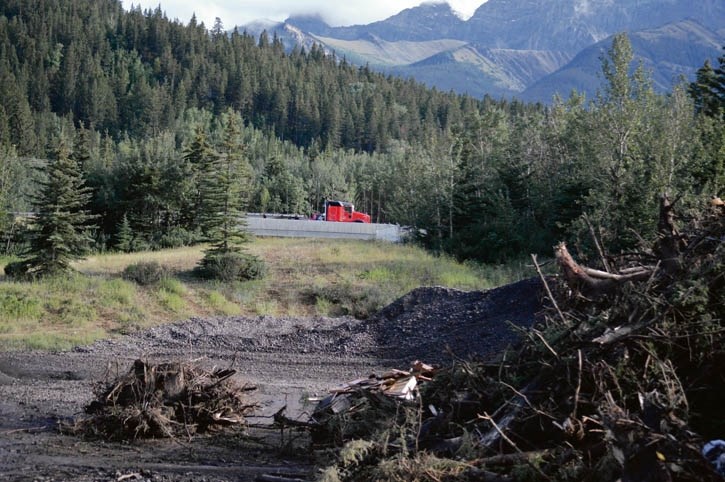The proposed Area Structure Plan is inching closer to reality following the MD of Bighorn acceptance of a Development Impact Assessment report (DIA) on the subject areas.
Council accepted the DIA for Dead Man’s Flats ASP for planning purposes as amended following a delegation brought forward by a consultant for Golder Associates Martin Jalkotzy on Sept. 8. Reeve Dene Cooper was not present.
The main focus specifically surrounded its potential impact on wildlife.
Jalkotzky saw “no issues” with the MD going ahead with the development, and said that the MD of Bighorn has the ability to mitigate any issue of wildlife movement identified in the north and east areas, which includes a wildlife underpass.
A second reading for Bylaw 12/15 (DMF ASP) will be in front of council at the Oct. 13 regular meeting.
On the table for the ASP is for 29 hectares of developable land in DMF that would create light-industrial and recreational development and provide an economic use to the MD.
The DIA looked at three main areas of concern – land use management, human use management and wildlife management.
In an overview, the DIA stated the need to reduce human-wildlife interaction in regards to the proposed development of the north and east ASP areas, and proposes mitigation to reduce environmental disturbances such as raising fencing used to direct animals away from the areas.
The east area, in particular, slated for light-commercial development, is a large gravel pit-type area and currently is being used as a temporary stockpile of materials. It also connects the Wind Valley Wildlife Corridor on the south side of the G8 wildlife underpass at the busy Trans-Canada Highway and Dead Man’s Flats at the recognized Bow Flats Regional Habitat Patch in the updated 2012 Bow Corridor Ecosystem Advisory Group’s (BCEAG) guidelines.
Councillor Paul Clark asked Jalkotzky for criticisms he could pick out of report if he was “on the opposite side of this issue.”
Jalkotzky said it has to do with “what we’re doing is an assessment and predication.
“One of the things we hear a lot from critics of this proposal is it’s going to have impacts above and beyond what’s occurring as if it’s a pristine site. The north side and the east side are not pristine sites by a long stretch,” Jalkotzky said.
“The biggest thing was they said, ‘You don’t know for sure’ and I would say ‘No, I don’t, but based on my experience and I’ve been at this now for closing in on 40 years, this is what I believe will happen and history has demonstrated quite clearly that lots of different places that my prediction ring true in that sense.’ ”
Jalkotzy said the subject areas haven’t been without human footprint for a while.
During a July public hearing, a lineup of opposition challenged the MD over the proposed ASP in an attempt to have it re-examined.
Karsten Heuer, a biologist and director with the Bow Valley Naturalists presented statistics, which showed since the underpass was completed a decade ago, wildlife use increased steadily until 2011, peaking at 684 events. Since, though, it has steadily decreased to just 284 events in 2014.
In a 2002 regional wildlife corridor study that examined wildlife movement in the DMF vicinity, its research showed that animal mortality on the highway occurred more east of the DMF overpass. However, the study suggested a corridor on the east or west of the hamlet would have been appropriate.
Other stats presented by Heuer on the underpass suggested approximately $85,000 is being saved per year as a long-term average on property damage, human injury and hunting revenue from road kills by having the functional underpass. He added there have been over 6,500 passages of wildlife in the area in the past six years.
A fence lining each side of the TCH is used block wildlife and to direct them to under/overpass for crossing safely. Councillor Paul Ryan asked Jalkotzky if a fence could be used to direct animals away from the ASP areas avoiding human interaction, much like it is used to direct wildlife to it.
“At the end of the day, critters are pretty smart,” Jalkotzky said. “Arguably getting a good fence in place over the years, critters will learn and once you have a forest growing up in that current gravel pit, there are elk around there now.”
What is suggested in the DIA is a proposed 2.5-metre fence in the east area boundaries that would connect to a fence in the north area.
Rob Ellis, MD director of planning services reiterated that when the wildlife fence was built along the TCH, the wildlife deaths on the highway went on a major decline.
“You can guide them there (using a fence) and you can guide them on the other side,” Ellis said.
Opposition to the ASP, which included Canmore Mayor John Borrowman, wildlife conservationists, and Canmore residents but no MND residents, mainly surrounded how this may affect wildlife and disrupt their movement.
Borrowman stated the Town would file an appeal to the Municipal Government Board if the MD goes forward with the ASP.
Borrowman noted the updated BCEAG guidelines were conflicting with the MD’s Municipal Development Plan. The guidelines state land management agencies should apply a consistent approach based on current information that will ensure the viability of wildlife corridors and habitat patches in the Bow Valley.
The MD of Bighorn has stated in multiple public forums that they never accepted the BCA terms despite the wording in the document.
“Just for clarity, (MD) council did not accept the updated 2012 (BCEAG),” said Ryan. “It’s not the first time (BCEAG) put something in their document that was contentious.”
Jalkotzy also pointed out the Three Sisters Campground located in the west side of DMF as being an issue with wildlife movement and in his opinion shouldn’t be there.
The DIA report said wildlife movement occurs in the adjacent ASP areas on the south side of the Bow from east to west.




